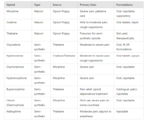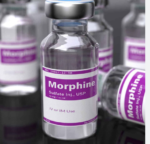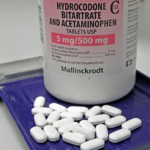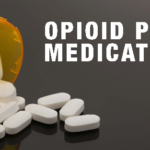Opioids, sometimes called narcotics, are a type of drug. They include strong prescription pain relievers, such as oxycodone, hydrocodone, fentanyl, and tramadol. The illegal drug heroin is also an opioid. Some opioids are made from the opium plant, and others are synthetic (man-made).]
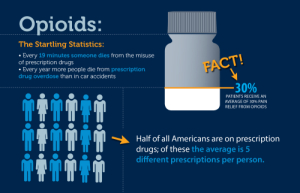
A doctor may give you a prescription opioid to reduce pain after you have had a major injury or surgery. You may get them if you have severe pain from health conditions like cancer. Some doctors prescribe them for chronic pain.
Opioids can cause side effects such as drowsiness, mental fog, nausea, and constipation. They may also cause slowed breathing, which can lead to overdose deaths. If someone has signs of an overdose, call 911:
- The person’s face is extremely pale and/or feels clammy to the touch
- Their body goes limp
- Their fingernails or lips have a purple or blue color
- They start vomiting or making gurgling noises
- They cannot be awakened or are unable to speak
- Their breathing or heartbeat slows or stops
Other risks of using prescription opioids include dependence and addiction. Dependence means feeling withdrawal symptoms when not taking the drug. Addiction is a chronic brain disease that causes a person to compulsively seek out drugs, even though they cause harm. The risks of dependence and addiction are higher if you misuse the medicines. Misuse can include taking too much medicine, taking someone else’s medicine, taking it in a different way than you are supposed to, or taking the medicine to get high.
Opioid misuse, addiction, and overdoses are serious public health problems in the United States. Another problem is that more women are misusing opioids during pregnancy. This can lead to babies being addicted and going through withdrawal, known as neonatal abstinence syndrome (NAS). Opioid misuse may sometimes also lead to heroin use, because some people switch from prescription opioids to heroin.
The main treatment for prescription opioid addiction is medication-assisted treatment (MAT). It includes medicines, counseling, and support from family and friends. MAT can help you stop using the drug, get through withdrawal, and cope with cravings. There is also a medicine called naloxone which can reverse the effects of an opioid overdose and prevent death, if it is given in time.
To prevent problems with prescription opioids, be sure to follow your doctor’s instructions when taking them. Do not share your medicines with anyone else. Contact your doctor if you have any concerns about taking the medicines.
Opioid analgesics may result in dependency. Operating a motor vehicle or machinery may be dangerous while using these pain medications because they can cause drowsiness. Opioids may slow down breathing. Mixing opioids with alcohol or certain other centrally-acting drugs could make this effect even worse.
Death and serious side effects have occurred with the use of fentanyl transdermal patches. Fentanyl patches are not recommended as starting therapy in inexperienced opiate users. Heat from the sun, hot baths, or heating pads can increase the speed of fentanyl release from patches.
Fentanyl buccal tablets have just one indication: treatment of breakthrough pain in cancer patients who are using and who have grown tolerant to opiates. Inappropriate use of fentanyl buccal tablets has resulted in death.
Methadone can affect the heart. Patients slated for methadone therapy should first have an EKG to check for abnormalities.
When the Prescription Becomes the Problem
- More than 191 million opioid prescriptions were dispensed to American patients in 2017—with wide variation across states.1
- There is a wide variation of opioid prescription rates across states. Health care providers in the highest prescribing state, Alabama, wrote almost three times as many of these prescriptions per person as those in the lowest prescribing state, Hawaii.1
- Studies suggest that regional variation in use of prescription opioids cannot be explained by the underlying health status of the population.2
- The most common drugs involved in prescription opioid overdose deaths include:
- Methadone
- Oxycodone (such as OxyContin®)
- Hydrocodone (such as Vicodin®)3
To reverse this epidemic, we need to improve the way we treat pain. We must prevent abuse, addiction, and overdose before they start.
Addiction and Overdose
Anyone who takes prescription opioids can become addicted to them. In fact, as many as one in four patients receiving long-term opioid therapy in a primary care setting struggles with opioid addiction.4,5,6 Once addicted, it can be hard to stop. In 2016, more than 11.5 million Americans reported misusing prescription opioids in the past year.1
Taking too many prescription opioids can stop a person’s breathing—leading to death.
Prescription opioid overdose deaths also often involve benzodiazepines. Benzodiazepines are central nervous system depressants used to sedate, induce sleep, prevent seizures, and relieve anxiety. Examples include alprazolam (Xanax®), diazepam (Valium®), and lorazepam (Ativan®). Avoid taking benzodiazepines while taking prescription opioids whenever possible.
Side Effects
In addition to the serious risks of addiction, abuse, and overdose, the use of prescription opioids can have a number of side effects, even when taken as directed:
- Tolerance—meaning you might need to take more of the medication for the same pain relief
- Physical dependence—meaning you have symptoms of withdrawal when the medication is stopped
- Increased sensitivity to pain
- Constipation
- Nausea, vomiting, and dry mouth
- Sleepiness and dizziness
- Confusion
- Depression
- Low levels of testosterone that can result in lower sex drive, energy, and strength
- Itching and sweating
Pain Medications, Pain Relief, and Pain Management
